Sarah Marino on a bowling date with her boyfriend, Kevin Becker, 22, at Star Lanes, in Polaris, Monday, March 4, 2019. . (Dispatch photo by Courtney Hergesheimer)
After suicide attempt at Ohio State, young woman finds new reasons to live
A quick glance at Sarah Marino might lead you to think she has every reason to be unhappy.
The 21-year-old’s petite frame sits in a hot-pink wheelchair. Her stick-like legs connect to small, motionless feet. A long thin scar travels the length of her spine beneath her long, blond hair.
There was a time not long ago when Sarah could walk just fine. There was a time when she rocked high heels on a night out, when she ran cross-country.
But it was those times, too, when Sarah’s anxiety and depression — and so many other things — consumed her.
At the height of that despair, Sarah made her way to the top floor of an Ohio State University parking garage.
Everything could have ended that day, Aug. 10, 2017, when Sarah jumped. The fall snapped her spine, shattered her feet, cracked her ribs and jumbled her brain.
But a passerby called 911. A squad rushed Sarah to the hospital. Doctors hurried to begin surgery.
It turned out to be a new beginning.
The day that left her body broken would be the same one to ultimately help her heal much more than bones.
The months of pain and surgeries have been anything but easy. But now, she dreams of a future she never used to see for herself. She’s happier than she’s ever been.
“You really see your true self, and how strong you are, when there’s no other option,” she said.
Sarah’s life has changed completely.
But she has a life to live.
Feeling hopeless
The idea had crossed her mind before, but the 19-year-old hadn’t planned it. So much simmered under the surface — the skipped work shifts, the apathy toward returning to school, the disappointment she felt she brought her family. But Sarah wasn’t thinking about any of it that late summer morning, not in particular.
If there was one notion that most pushed through the fog that surrounded Sarah that day, it was the sense that this would be for the best.
The morning itself was a blur. She doesn’t remember the details — the 81 steps to the top of the parking garage, or the gray grit of the fifth-floor pavement beneath her shoes — before she jumped.
Sarah had tried to harm herself before, during her sophomore year at Bishop Watterson High School in Columbus. And then she’d been sexually assaulted during her freshman year at Ohio State. She kept both secrets for months.
There were arguments with her parents about skipping work and experimenting with marijuana. But Sarah was 19 at the time, and Charlene Marino attributed those clashes to her daughter’s age.
"You know, as a parent, you sit there and you question, what signs did I miss through all of this?” said Charlene, 51.
Sarah had been grappling with what her doctors have since diagnosed as anxiety and depression.
“I just felt like I was hurting people a lot,” Sarah remembers thinking as she weaved through campus that day in August 2017. “I felt like I couldn't get better."
Suicide-prevention experts agree that suicide is complex but preventable.
Nine out of 10 people who attempt suicide and survive do not ultimately die by suicide.
“For most people, suicide is a point in time,” said professor Darcy Haag Granello, founder and director of Ohio State’s Suicide Prevention Program. “And if you get through that point, they’ll never be suicidal again.”
If you or someone you know is considering suicide:
• Call the Franklin County Suicide Prevention Hotline at 614-221-5445; the Teen Suicide Prevention Hotline at 614-294-3300 or the National Suicide Prevention Lifeline at 1-800-273-8255; or text the Crisis Text Line at 741-741; or connect to the Lifeline Crisis Chat at crisischat.org.
• For the Ohio State community: Reach Ohio State's counseling center at 614-292-5766 during regular business hours, and by pressing "Option 2" after hours.
Warnings signs of suicide:
• Talking about wanting to die, feeling hopeless, being a burden to others, feeling trapped or unbearable pain.
• Increased use of alcohol or drugs.
• Displaying anxiety, depression, loss of interest, irritability, humiliation, shame, agitation, anger, rage and/or relief or sudden improvement
• Sleeping too little or too much.
• Withdrawing from activities and/or feeling isolated.
If someone you know shows warning signs of suicide:
• Do not leave them alone.
• Remove any lethal means (firearms, alcohol, drugs sharp objects, etc.).
• Call the National Suicide Prevention Lifeline.(1-800-273-8255)
• Take the person to an emergency room or seek help from a medical or mental health professional Sources: American Foundation for Suicide Prevention, www.ReportingOnSuicide.org
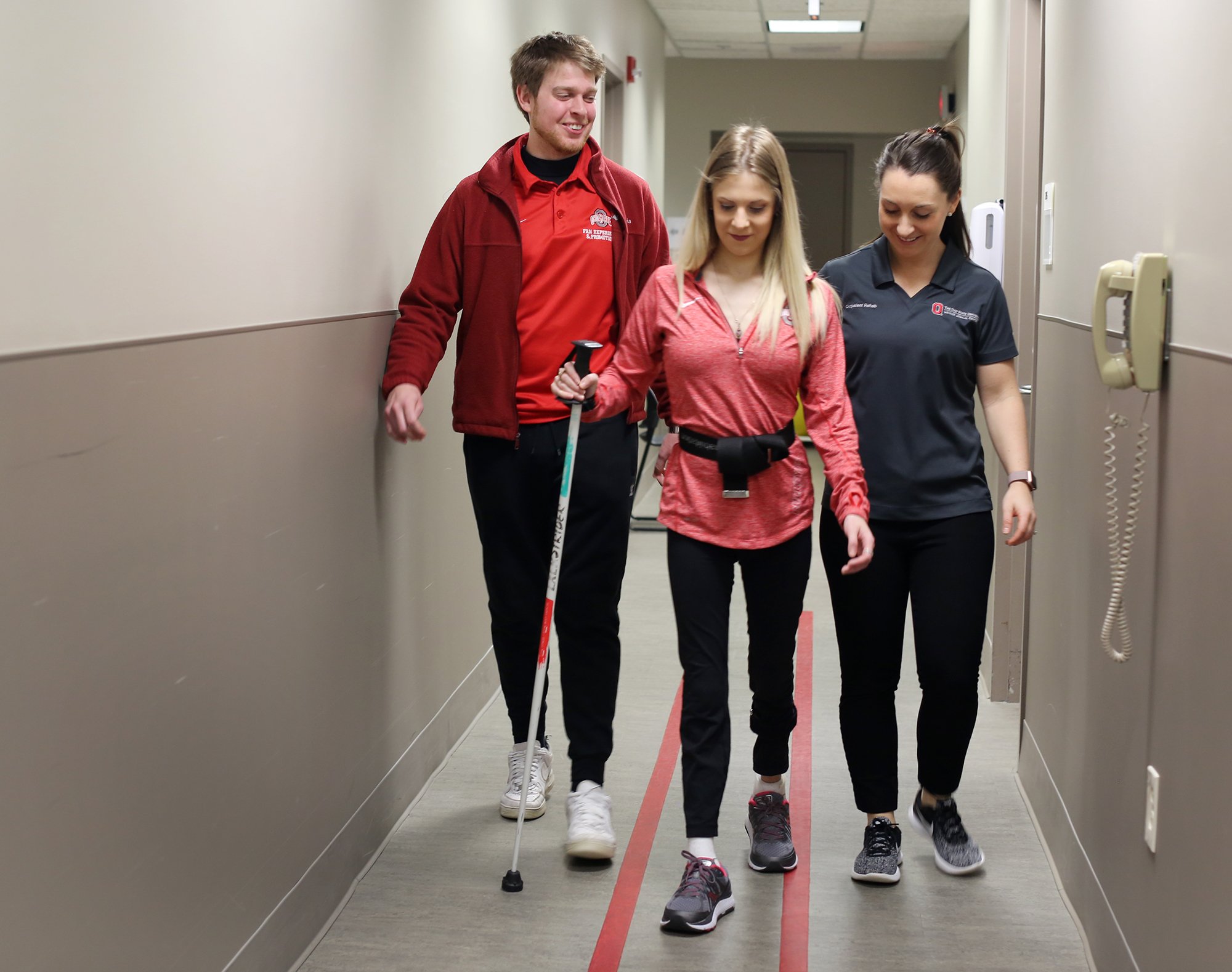
A long road
Sarah gripped two tall poles as Ohio State physical therapist Alicia Almond held her steady with a band around her waist last month. With a wobbly walk, she worked her way through the bustling rehabilitation area at Martha Morehouse Outpatient Care center, off Kenny Road on West Campus.
Just getting to these twice-weekly appointments takes work: a wheelchair ride down the fresh wooden ramp attached to the Marinos' front porch in Delaware, a scoop from Sarah's mom into the family minivan and out again, a ride up an elevator, and then maneuvering to her destination.
Even so, it's a far cry from her first physical-therapy sessions in the hospital, where she stayed for seven weeks after her suicide attempt.
"I remember, like, falling over just trying to sit up on the hospital bed," Sarah said.
The first thing Sarah felt when she woke up in the hospital after her attempt was fear: A stranger was shoving a tube down her throat.
What came next wasn’t clear-cut relief. It wasn’t tangible anger, or overwhelming regret.
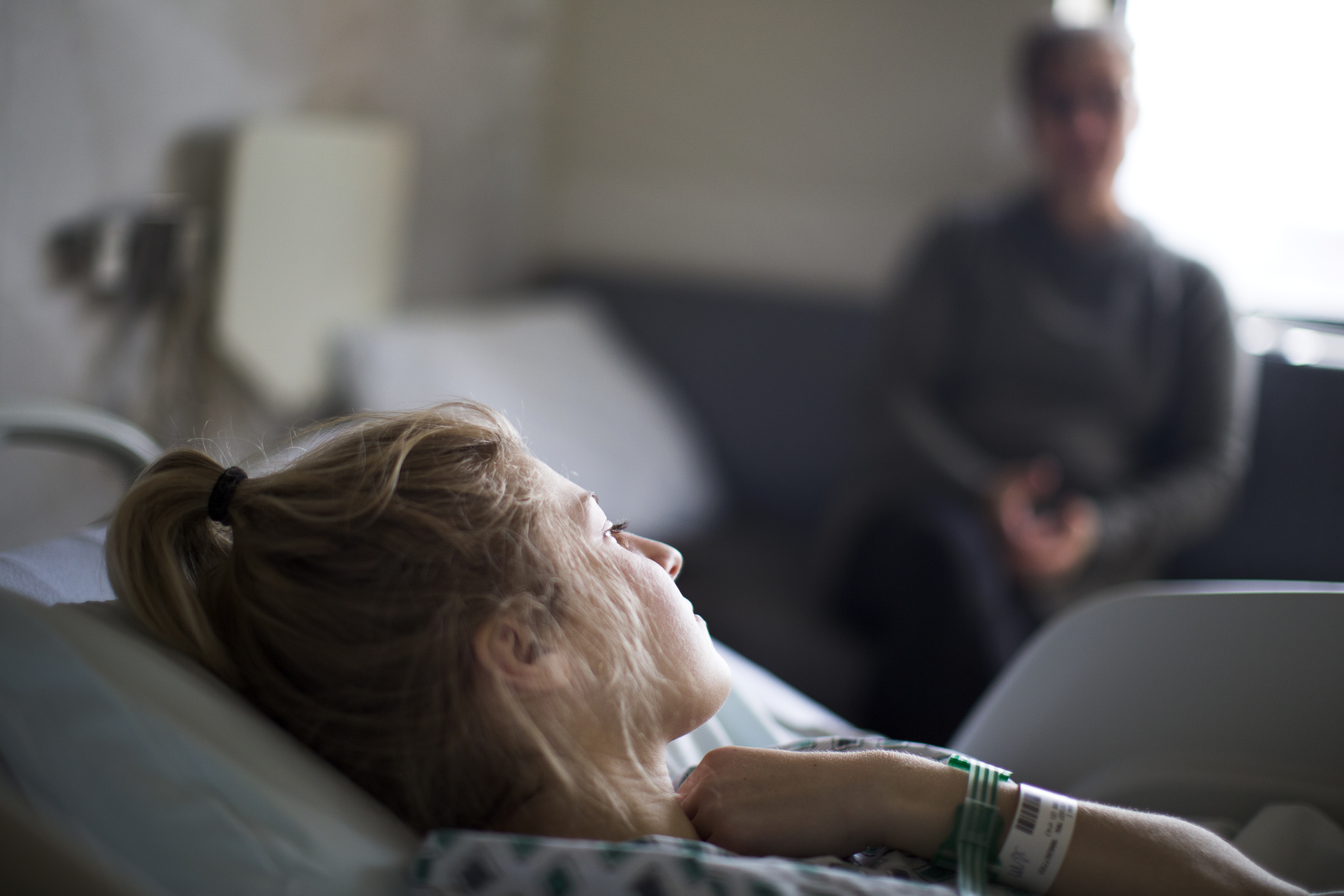
“Well, I'm alive now,” Sarah remembers thinking. “But I was in a lot of pain. It was weird. There was ... not that revelation thought like, ‘Wow, I'm alive, like I'm so grateful.’ ... I was, but at the same time, there was a lot more going on.”
When Sarah arrived at Ohio State's Wexner Medical Center, doctors worked quickly to triage her life-threatening injuries and coordinate the first of what would eventually be eight surgeries.
A severe fracture to one of her L2 lumbar vertebra meant Sarah initially couldn't move her legs. Doctors focused there first, working to decompress her spine and repair the fracture, ultimately placing two vertical rods with a series of screws along both sides of her spine and down to her pelvis, which also was severely fractured. Doctors positioned a screw nearly the length of a mechanical pencil across the back of Sarah's pelvis, and a temporary plate across the front for stabilization.
The fall broke and dislocated multiple bones in Sarah’s feet and ankles. Doctors would later fuse foot and ankle joints in her right foot, limiting its movement.

Sarah has regained function throughout much of her legs, hips and knees. But a lack of sensation and movement throughout her ankles and feet remains. Doctors are unsure how much she'll get back.
Sarah might always have to rely on assistance devices such as walkers or her wheelchair.
"Twenty-one with, like, the body of a 90-year old," Sarah quipped with a smirk during physical therapy last month.
None of that stopped her on a recent trip to the bowling lanes, where her hands worked the wheels of her wheelchair with poise.
Beneath her caramel cropped fur coat — a favorite accessory — her arms have grown larger than her reed-thin calves and ankles. The rubber of her wheelchair squeaked as she rolled up to the lane, grabbed a marbled bowling ball from her boyfriend, Kevin, and sent it crashing into the pins.
Rock-hard support
As Sarah worked to heal her body, she focused on her mental and emotional wounds, too.
Sarah works to manage her mental illness every day.
Some days are good and others not so good, Sarah said, like when she wishes she could isolate herself, pull away from those closest to her. Other times, she’s irritable because of the pain from her physical injuries.
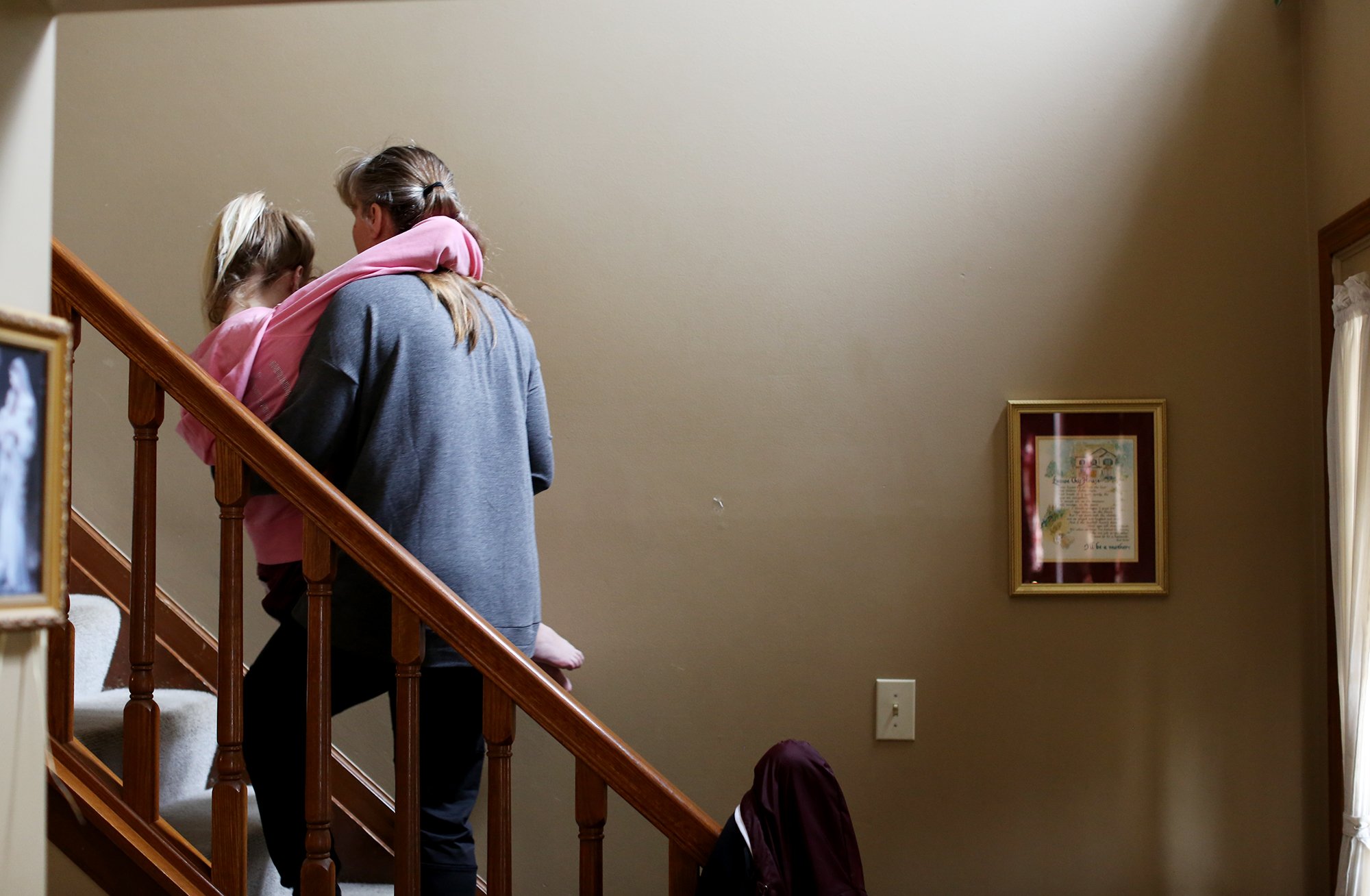
She knows her anxiety and depression will need attention for the rest of her life. She takes medication and sees a counselor and psychiatrist regularly. She is learning how to cope with daily anxiety through meditation and rerouting her thoughts.
And she's found the people and the care to lift her up when she needs it: close friends, family, her boyfriend, her doctors, her counselor, her physical therapist, and her spinal-cord support group, all the people and things she calls her "rock-hard supports."
So many of those people want her to know: They're not going anywhere.
Charlene has reduced her time as a nurse at Scioto Family Physicians to a contingent basis so she can care for Sarah and get her to appointments.
Kevin Becker, 22, remembers the questions people asked about his relationship with Sarah after her suicide attempt — if it was really what he wanted, if he could take it all on. They'd been dating less than three months then.
"When people say, 'Are you sure this is the right thing? '... I'm like, yeah, it's the right damn thing," Becker said. "Because I love Sarah. So I'm going to stay with her and make sure that she becomes better."
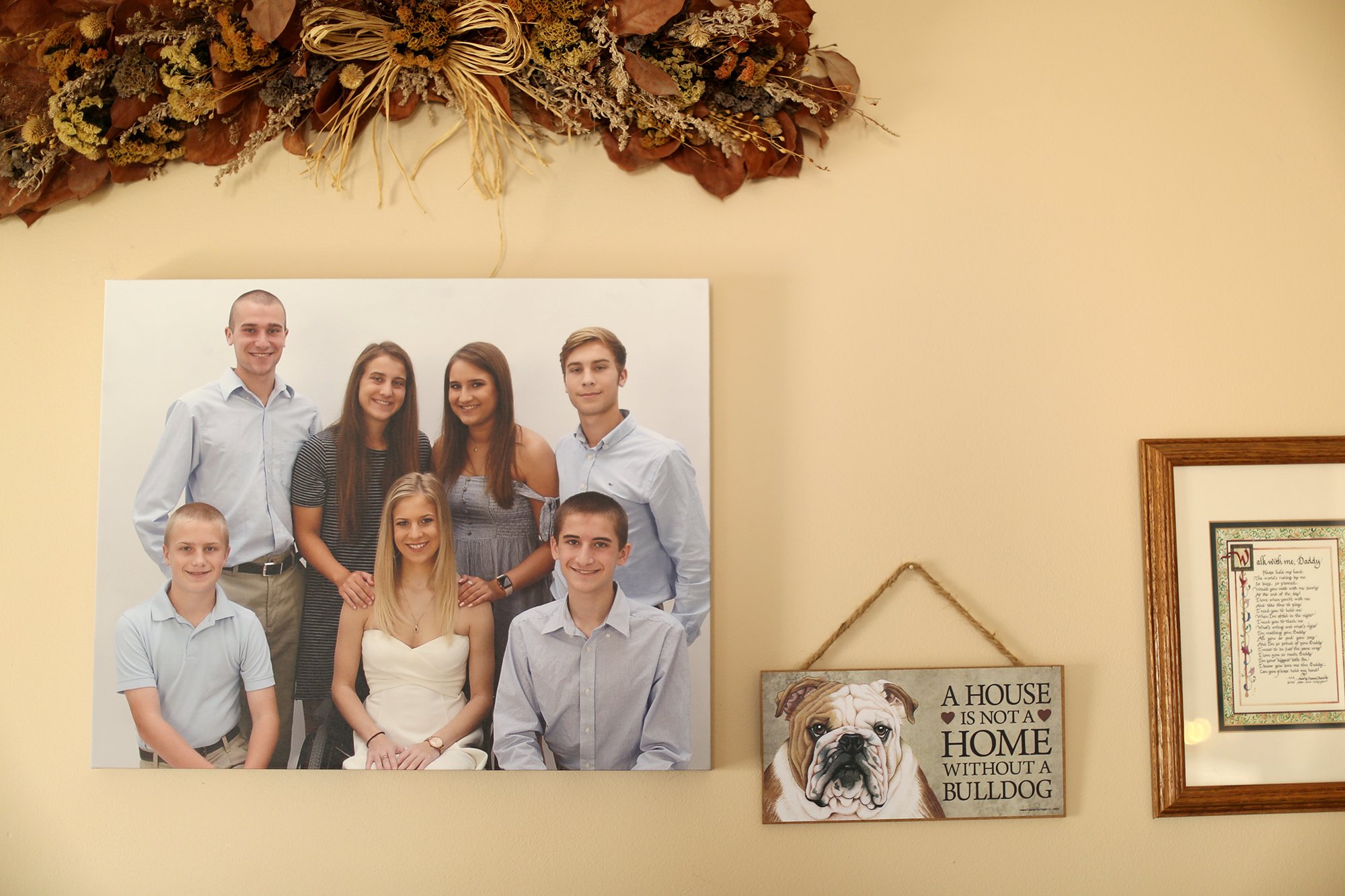
Family dynamic
On a weekday evening, the Marino family’s Delaware household had the calm buzz of a human beehive. Charlene stood over a stove of stir-fry as she rattled off a roll call of who in her large family was off to practice, who wasn't home yet and who had a test the next day.
In the center of the family room was a hospital bed with light pink and gray plaid blankets. Rumpled clothes and a pair of sequined, shiny Ugg boots were shoved underneath.
This makeshift bedroom has been the setup since Sarah came home from the hospital: on the ground floor, close to a bathroom, with help almost always nearby.
The family’s English bulldog, Rudy, waddled toward Sarah’s bed. She touched his nose with a quiet “boop.”

“The family has been changed by this,” Charlene said. There was — and still is — worry, confusion, sadness and anger about what happened.
“Everybody was concerned; that goes without saying, but ... they're all dealing with things in a different way,” Charlene said of her family, with seven children who range in age from 12 to 22.
Sarah knows it.
“I wasn’t trying to hurt them … I never would,” she said of her family. Sarah stopped herself. Her voice caught as she searched for the words.
Sarah hopes her family doesn’t feel blame or guilt for what happened. In some ways, it’s opened up new, needed channels of communication on mental health, she and her mom said.
“It's gonna be a long process,” Sarah said. “I mean, it's been one day at a time since Day One, and that’s how, I think, every day should be taken.”

Opening up
Within the past calendar year, at least three people jumped or fell from parking garages on the Ohio State campus. Two of them died.
The news of those falls filled Sarah with anxiety. Though her attempt didn’t garner immediate media coverage, she couldn’t help but wonder whether it had planted a seed in someone else, a phenomenon researchers call suicide contagion.
Her mother flashed back to that day in August 2017 — the worry and angst. And then comes guilt.
"I don't know exactly what they might be experiencing, but I know what we experienced," Charlene said. "And you wonder, you know, she jumped from the same level as other people. How is it that she's still here?”
Sarah is grateful every day that she did not become part of a troubling statistic: Suicide is the second-leading cause of death among people ages 10 to 34, second only to unintentional injury, according to the Centers for Disease Control and Prevention.
Though experts maintain there is no single cause of suicide, many worry about the anxious environment in which young people are growing up, in a flood of connectivity, social media and comparisons.
“It’s all day. It’s every day,” said Granello of the OSU suicide-prevention program. “It’s this constant comparison we make every time we pick up our phones, and we never measure up.”
Anxiety and depression remain the most common concerns among students seeking help at college counseling centers, according to a 2018 report from the Center for Collegiate Mental Health at Pennsylvania State University.
More than 62 percent of students reported feeling overwhelming anxiety in fall 2018, up from about 49 percent a decade earlier, according to surveys from the American College Health Association. In 2008, nearly 6.5 percent of students reported that they had seriously considered suicide in the past 12 months. In the fall of last year, that number jumped to 11.3 percent.
After two of the incidents at Ohio State parking garages last April, Sarah began opening up more publicly about her experience. Early on, close friends and family knew what had happened, but sometimes Sarah simply said her injuries were from “a bad fall.”
After those other incidents, Sarah shared her story — her mental-health struggles, her suicide attempt, her injuries — on Instagram.
“That’s when I first realized that like, there are a lot of people going through similar things,” she said.
As much as social media concerns suicide-prevention experts, it's for this reason that some said it can be helpful, too. It provides a new way to reach people who might be in distress, or to hear from those who have overcome a crisis and are dealing with their struggles in a healthy way, said John Ackerman, suicide-prevention coordinator at Nationwide Children’s Hospital.
“We’ve got more opportunities to hear from those who have attempted suicide and lived healthy lives,” Ackerman said.
Sarah knows her first focus has to be on her own well-being. But she also feels she’s been given a chance to help people who are feeling the same anguish she once knew all too well.
“There's plenty of time to get better. There's no timeline with mental health,” she said. “And it's something that you don't have to be mentally ill to work on. It's part of us, it’s your brain, it’s your body. It's just like eating and drinking water and taking care of yourself.”
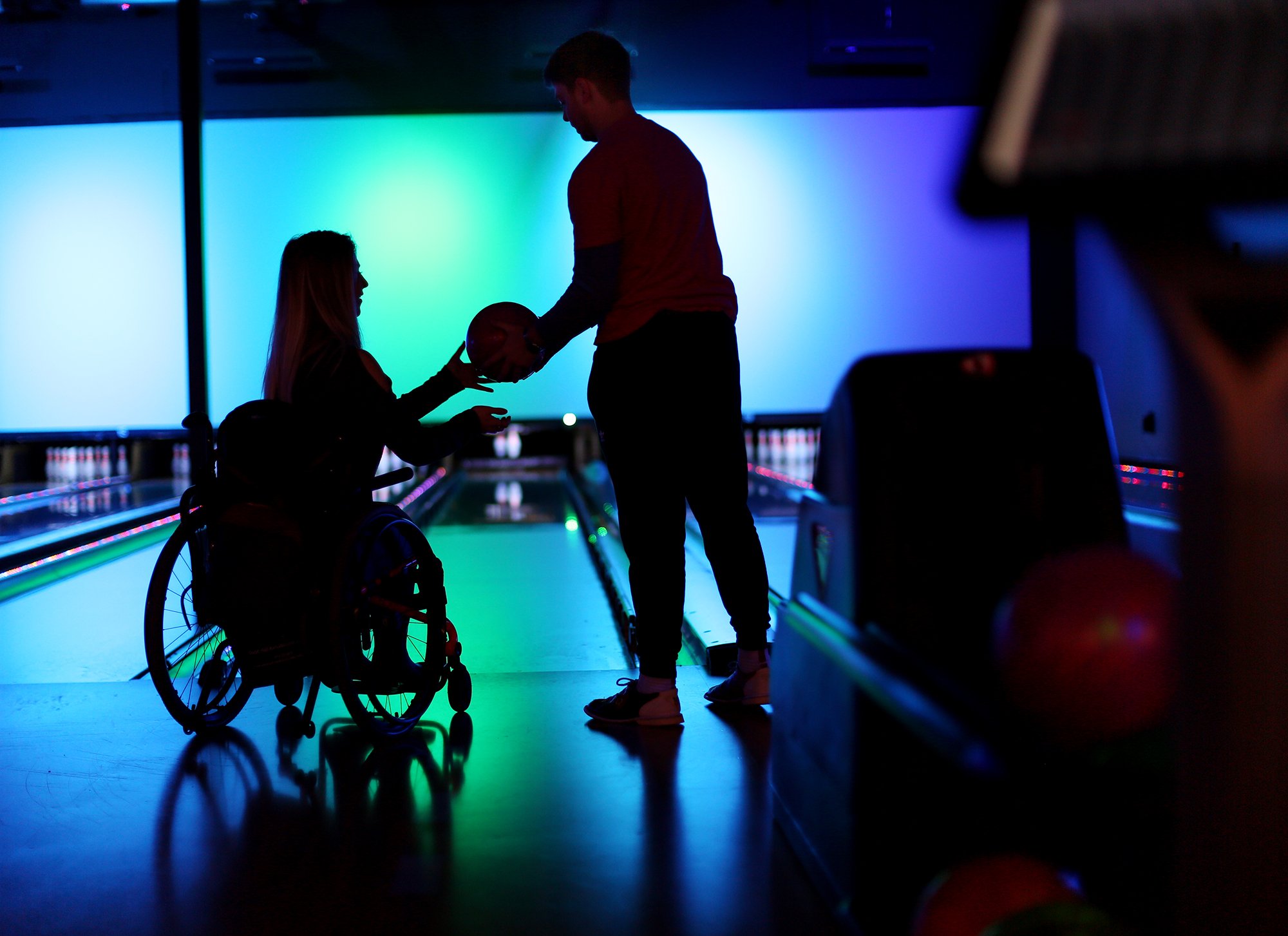
Looking ahead
Sarah’s hazel eyes gleam as she talks about what lies ahead: finishing her degree, traveling to new places, someday becoming a mom.
She took some online classes last year, but recently put school on hold because she can't get full aid and scholarships as a part-time student. She hopes to still complete her degree in health sciences, in part because of her recent experience with so many in the health-care field.
Most people don’t have to put the brake on a wheelchair to avoid careening down a bowling alley. Most young adults don’t have to worry about arthritis. Many don’t have to explain the physical ramifications of their darkest day.
Her doctors call Sarah's optimism remarkable. That, along with her strong support system, has aided her physical recovery, they say.
"She has a very positive attitude," said her neurosurgeon, Dr. Stephanus Viljoen. "That helps with everything. It helps with her motivation in therapy, it helps with her pain."
Sarah recently celebrated her 21st birthday with metallic pink balloons and sparkling rosé. She is always up for a Starbucks run and cuddles with a drooling Rudy.
She's happier now than ever. She’s thankful for surviving, she said, but also for her family, friends, Kevin, the closer bond she’s developed with her mom — too many things to list, really.
“There’s just so many things that I'm grateful for,” she said.